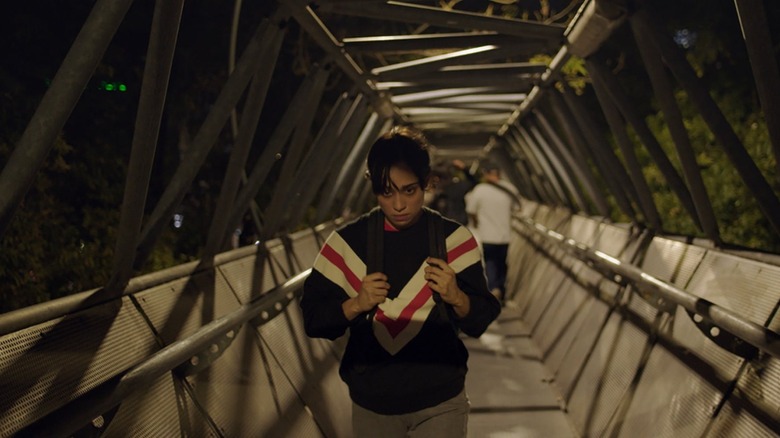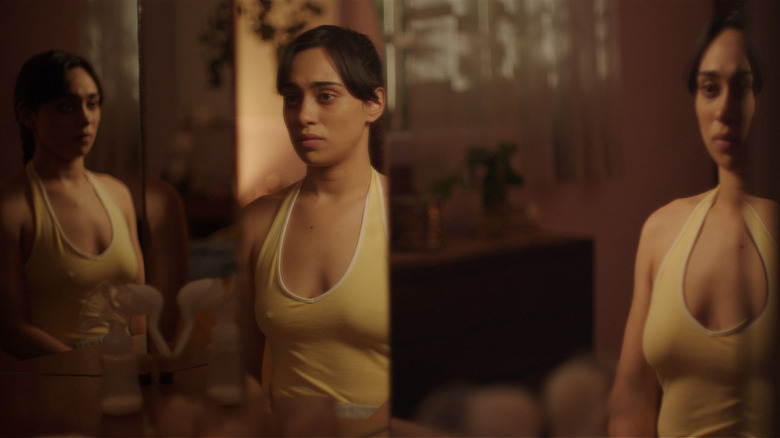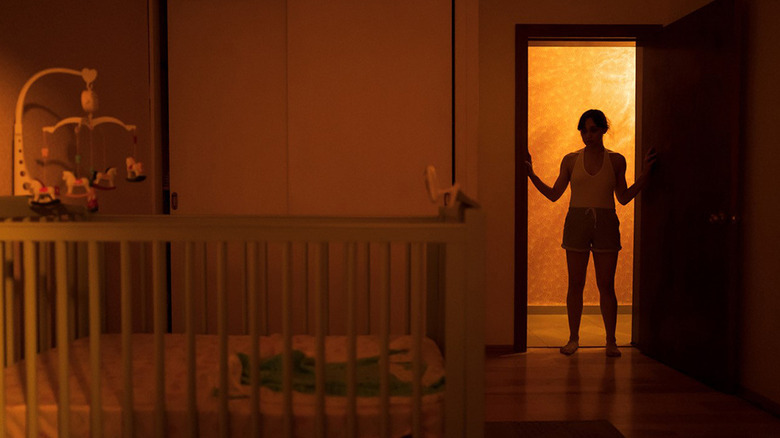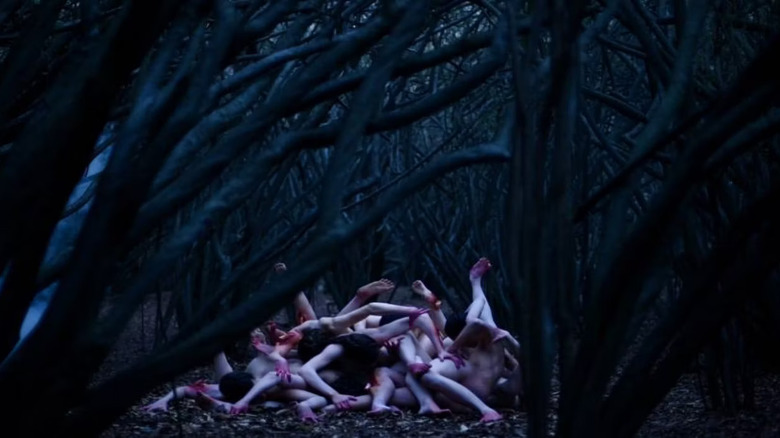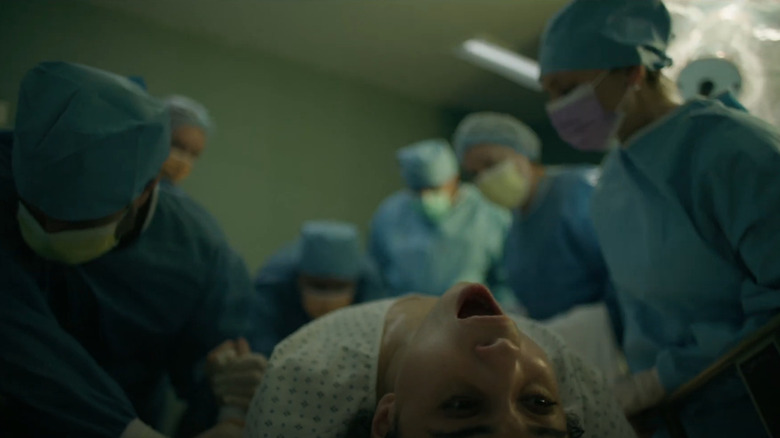Huesera: The Bone Woman Director Michelle Garza Cervera Is Inspired By Nightmares [Exclusive Interview]
"Huesera: The Bone Woman" is a horror movie that attacks all the senses. Loosely inspired by the folk tale La Huesera (translation: the bone woman), co-writer and director Michelle Garza Cervera places audiences in Valerai's (Natalia Solián) point of view as the protagonist fights to survive a supernatural curse in a society already damned by expectations. Every sight, sound, and fright is personal.
Cervera first heard the folktale of La Huesera in her 20s. It's a story that spoke to her about identity and freedom. For years, she kept the tale in mind and finally co-wrote "Huesera: The Bone Woman" with Abia Castillo. The end result is a visceral horror film with internal and physical scares. Without spoiling anything, Cervera hopes audiences leave the movie with hope. The director, whose short film "La Rabia de Clara" you can watch here, recently took us behind-the-scenes of her striking feature directorial debut.
Note: This interview has been lightly edited for clarity and brevity.
'She turned into a goddess of my life and she was asking for sacrifices'
You open with a grand shot of the Virgin Mary. For you, what was her importance in the story?
Our Virgin Mary in Mexico is Virgen de Guadalupe. I feel like in Mexico, and in many cultures, there are two big portrayals of women, which is either you are a virgin, the protector and the caring woman, and perfect. You are this super mother that takes care of everyone around her, but never of herself. And then the other aspect of, in the case of Mexico, is this La Llorona, this terrible woman that can't control herself and ends up killing her kids. There's a big talk in Mexico about how sometimes they want to put us either in one of those two boxes, and both of those two boxes are inhuman and not real. There's such a huge gray scale between those concepts.
I wanted to start the film with this thing that defines our lives that is so huge and so sacred that it is motherhood. I feel like that place portrayed it in the best way. That's how it feels, that social expectation, of the path you have to follow in life. It is that huge. It does define your life. To challenge that is not easy. So, I think that was the right way to start the film with this huge image of the Virgin that makes you super tiny compared to it.
After showing the film in Mexico and elsewhere, what have your conversations with women been like afterward? How do they relate?
It's been amazing, honestly. Even last night we had a screening and there were so many Latina women in their 40s or 50s. To me, it's awesome to see how much they're relating to the film, and they're loving a horror film, when it's not exactly the genre that they tend to watch. To me, that's a specific audience, like my aunts and my mom, if she was here; that's the audience that I want. I love every audience, but to me, it's very special that the film speaks for a lot of the silence that they hold through their lives. When they finally see something portrayed that speaks to everything that they've been holding up for so long because of the social expectations that they're submitted to, that's beautiful. I've had amazing approaches after screenings, in tears and very moved by the film. It gives sense to this crazy process of making a film.
And there's also the crazy process of creating a human life.
Exactly. It's similar in some ways.
Can we go down that path? What are the pains of making your first movie?
Honestly, it is a marriage in many ways. I committed to "Huesera," and in that moment, she turned into the goddess of my life. She was asking for sacrifices in every aspect of my life. I changed so much of myself and of my work ways or my personality, even. Many things in my life were affected by this project in all the layers. My family dynamics changed because I was completely, profoundly immersed in an investigation. Even putting into focus the way I have relationships with my family and the way I want to live my life, because that's what the film speaks about. So, there was no way I could escape from that. It was our best film school, but also, it's not easy. Now, I'm about to start the second one, I'm like, "Is this one going to take me, too?" But I love it. I couldn't be happier. I love living to make films.
It is a very introspective horror movie that also deals heavily with shame and regret. Were those themes always on your mind?
Completely. They're trying to reach freedom, and it's so hard because there's so much shame. There's so much fear to regret, and there's so much guilt. There's this expectation and all humans, we have it, but there's a huge expectation on women that we have to say yes or to be comfortable and to always be easygoing, and to set boundaries is not an easy thing to do. It becomes very suffocating, and it becomes terrifying in many aspects because then at one point you're like, "Oh my God, when did I subscribe to this life? I never know in what moment of my life I said yes to all of this that now is my life. What if I wanted something else and I will never know now?" To me, when I found that was a theme for the film, it was perfect for a horror film.
'We f*** up every day'
Maybe I'm wrong, but I liked the idea of these faceless figures in the movie, almost a visual representation of shame and regret.
Yes, there is a broken identity thing. It's seeing yourself in dark aspects that you don't want to look at. And yes, it does have to do a lot with calling it up just for yourself. You don't have enough space to open up and speak about these things that you think you're the only one that's feeling it. You feel like you're a monster because you thought something very dark for a moment about your baby. The thing is that when you open up, you understand that everybody has those feelings and those thoughts. We have not done the work of normalizing it.
It's not easy, I think, for a woman to speak about it. Even so many of the women involved in the film, they're moms, and they opened up thanks to the film's conversations about these aspects of motherhood. And even themselves, it is very hard to articulate. It is really deep down, they feel like they're terrible people because they have thought of wanting to leave their babies for 10 minutes. And it's like, no, it's actually quite normal. It's very human, and there should be more space to speak about it.
Because we don't see it that much in movies, it is also nice watching women make wrong or, pardon my language, f***ed up choices.
Yes, yes, yes, yes, yes. I feel it because that's the most human experience. We f*** up every day and then we do amazing things as well. We're elastic people. We're in constant change the whole time and there's no way to fill the box of being perfect, being a great woman, a great mother, all the time. There's no such thing as that. I do think trying to reach that is what actually can bring the most violent and toxic behaviors to a home.
How else did you want to visualize some of these themes?
All the answers for camerawork are really in the script in the sense that the [rewriting] and the constant investigation of a project starts giving you the answers. There's a moment where you put so much work into the script that you're doing the shot list. The script tells you, this is the important thing to see here. There's already this set of rules, like what a spider web means in the story. So then, oh my God, if we put something here that looks like a spider web, it's going to be loyal to what the scene is trying to [say].
It was my first film, but my friends that are writing their first features right now, that's my big advice. You have to invest a lot of time in writing. It brings up the answers for the camerawork and the sound design. There's so much of filmmaking that comes from the concept. To make it tangible is not easy, but that comes with the rewrites.
I feel like that's a good way of describing rewriting: Investigating.
Yes, because it is a huge process of investigating. For us, it's an investigation of the character. We read so many film analysis essays about horror. All these studies about representations of women in horror and all that, that's something that we studied because we wanted to create something that gave another portrayal of women.
I've seen you reference one of the best horror movies in this regard, "Possession."
Yes.
That seems like a movie more and more filmmakers are taking inspiration from, right?
Yes, totally. I think it has to do with the fact that they are fearless. That actress was not contained in any way, and I love that. It's something that I'm very happy with my actress as well, because sometimes we are very scared in films to cross the lines, but we have to. We have to be risky, we have to take those risks.
Did you talk to Natalia about "Possession"?
We watched it in a film club that we had every week with the cast and crew, so that was one of the films that we analyzed.
What were some of the other movies in the film club?
We watched, of course, "Rosemary's Baby," and we watched "Don't Look Now," and "Jacob's Ladder" was a big one. Of course, "The Babadook," "We Need to Talk About Kevin," and "La ciénaga" by Lucrecia Martel.
'Jacob's Ladder is the biggest reference in the visuals'
Let's talk about some of those references. Like "Don't Look Now," this is a very colorful horror movie, even with the nighttime photography. Was that the goal?
Yes, yes, yes. We also wanted to challenge this idea that the harmonious pastel domestic life can be terrifying, and that we wanted to give that colorful world a horrific aspect to it. And then on the other hand, having a world from the punk scene being a dark world, even though it was colorful in many aspects. Octavia's (Mayra Batalla) world tends to be a darker palette, but that world in the film holds more freedom. The less terrifying world is that one in the film. We were really working on color, trying to change the concepts, I guess, of what is impregnated to each color's significance, if that makes sense.
Now that you mention the punk scene, that's very much like the party scene in "Jacob's Ladder."
Totally, yes. I love the people that recognize that because I know they're film lovers, but there's been you and other three people that have been like, "Oh my God, 'Jacob's Ladder.'" It was what inspired that punk scene. "Jacob's Ladder" is the biggest reference in the visuals. It's the way of storytelling that I like the most.
You really tap into how scary children can be, just the fact they haven't developed a filter or are just learning to be a person.
[Laughs] I love that.
How did you want the kids to heighten the anxiety and horror in the movie?
For example, in the case of "Don't Look Now," there's a curse around Valeria, she wants to connect with children, but there's something that is hostile from those figures, and it feels like it's in her surroundings. We did build from that, and it comes from the fact that she hasn't been able to look at them as what they really imply. The climatic moment in the film, I don't want to reveal spoilers, but it has to do with Valeria looking directly into an infant and understanding that's another human being. It's about taking a decision because of a social expectation that regards the life of another human being is maybe not the best way to go.
I wish we could talk more about the climax of the movie without spoiling it.
You mean the woods part?
Yeah. How did you get that done with the resources you had?
As I was saying, the rewrites gave form to how the entity of La Huesera should work for the film. I knew I wanted to show the poker cards at a certain point, and to take La Huesera to a final form. It was hard with our budget. I also don't like CGI, and I didn't have the budget for that. I realized I could really do it with a group of dancers, and I thought that sticks with the rules that we've set up for the entity, and that's something that I could film, literally. It was amazing. It was a very cool process with a very cool choreographer from Mexico. His name is Diego Vega, and we had a long process of casting dancers and rehearsals. It was super fun.
I'm with you: CGI usually feels out of place in horror movies.
You know what, I'm actually not really against it. I am more the kind of director that if I can, I would love to have a great mix of practical and CGI. I don't know if you watched the film "Hatching"? It's from Denmark, I believe. The monster is really a 50-50, and it's magical, because it feels real. It's practical, but the details help from the CGI. What I'm trying to say is it's more 60% practical, and then only 40% you help out with the CGI. I'm not against CGI. I think that you can do very cool things, but it's not easy to do it. For me, I need to have a lot more experience to learn to do it in a way that I like, because most of the time I don't like it, as you mentioned as well.
What are you working on at the moment?
I'm working on my second feature, which is going to be filmed this year. It's more in the cosmic horror world. I will use some CGI, but I'm trying to see which will be the best way to do it. There's a TV series coming out in April, and if you're in the U.S. you can watch it on this platform, ViX+. It's a cool project because we are nine directors in the horror world from Latin America, and each one of us directed a 30-minute episode. They gave us a lot of freedom, and I felt my episode was very authoritative, and I can't wait for it to be out. It's actually a reboot of "La hora marcada," which was a TV series where Guillermo del Toro and Alfonso Cuarón directed episodes. I think it's going to be an exciting project. I haven't watched the other episodes, but they're very good directors there, so I really recommend that.
'If I'm not following my gut, I start having nightmares'
What are some lessons from "Huesera" that you want to keep in mind for your next film and other projects?
You have to surround yourself with the best team that believes in you. The people that you're surrounded with in your team have to be believers of the project itself. They have to be passionate about it, and then everything is going to be easier. That's one. Believing in the rewrite and taking the script into the point that you're 100% sure. There's no moment that you're going to say it's perfect, but there's a gut feeling that it tells you, "Okay, I'm ready."
Maybe the biggest one would be to really follow your gut. I am the kind of person that if I'm not following my gut, I start having nightmares, or I can't sleep and I feel bad. My body expresses a lot, like that anxiety when I don't feel like I'm taking the right path. I've understood that every time I follow my gut, that's where everything comes out in the best way. It's trying to listen to your instinct and following it.
Do you ever find your nightmares inspiring?
Totally. I do have a lot of nightmares and actually many things in "Huesera," they come from the kind of nightmares or the kind of fears that I have. Actually, the image of the woods in "Huesera" that you asked about, that image I got on an insomnia night. I couldn't sleep, half awake or half asleep. I do use a lot of those psychic, weird things. It's good material.
Since you talked a lot about rewriting and investigating, how did the final draft compare to the first?
It was completely different. We officially did 13 rewrites of the script. I think it was even more, to be honest. The only thing that I had for sure is the ending, that I knew I wanted to take a character from believing in that domestic life, to the point of that ending. Building a full character, that was the hard part, understanding who Valeria was, because I knew the concept of taking a character from point A to point B, but then giving her all this backstory and all the layers, was what the rewrites gave me.
It's such an internalized performance, too. How much do you or can you express that on the page?
Yes, that's the thing. Actors really, oh my God, they bring so much to the stories, and I do work with them on the script as well. I do a lot of readings and sessions of analyzing the script, and then I let them participate, so they edit the script in their own ways as well.
What about the bones cracking in the movie? Was that old school, like a sound designer breaking celery?
The sound designer did go through many vegetables, like carrots and many, many vegetables, and chicken bones and stuff like that. But honestly, he ended up really cracking bodies. He has a niece, I think, that she really cracks her body in crazy ways, and he recorded her. It's a different mix of many materials, including wood. There are many real cracks. Even the actress was cracking her bones on the set as well.
It didn't hit me until now, but the character is a builder in the movie. She's a carpenter, a maker. How did you land on that idea?
I grew up in a house of designers. My parents were both in that field, and that was inspiring for me. But then also I liked the idea of giving her this aspect of being a builder of domestic objects, and how she can build that for that life path, or for another path as well. She ends up carrying her toolbox, and I feel that's something cool, that you can take your home with yourself, in a way.
There's that line in the movie about you being your own home. Something to aspire to, right?
Yes, that is true. Goals. Those are life goals.
"Huesera: The Bone Woman" is now playing in theaters and available on Shudder starting February 16, 2023.
